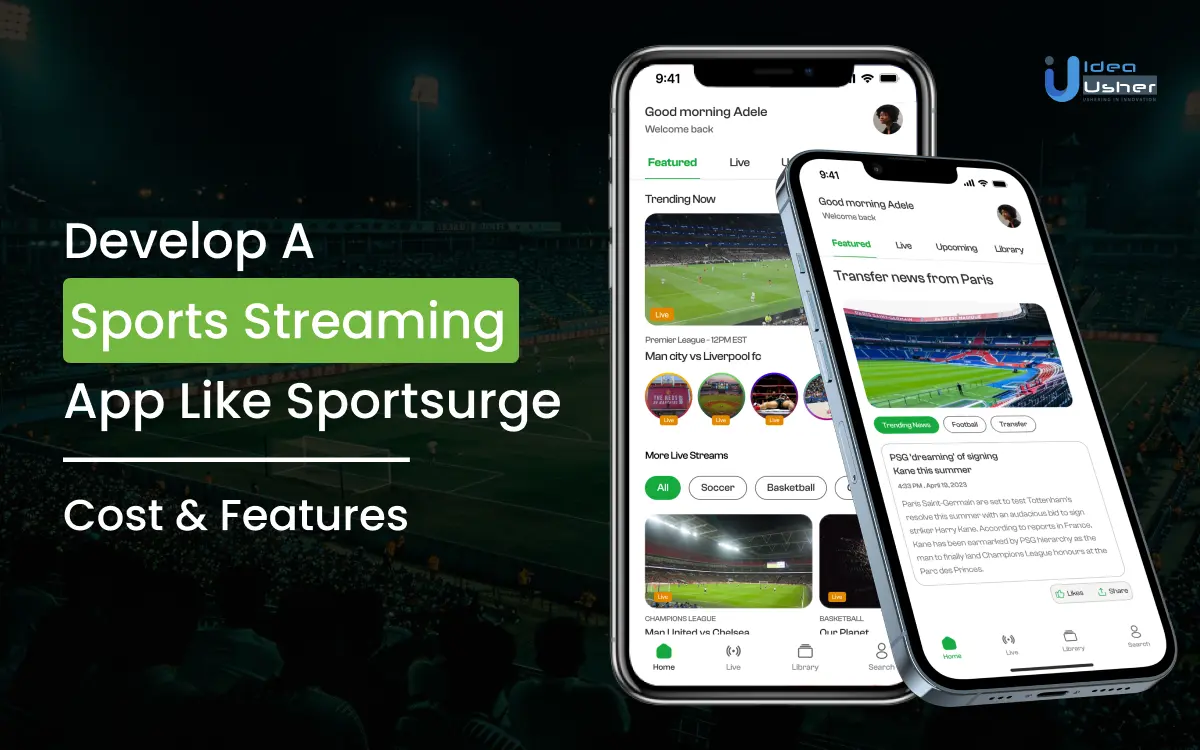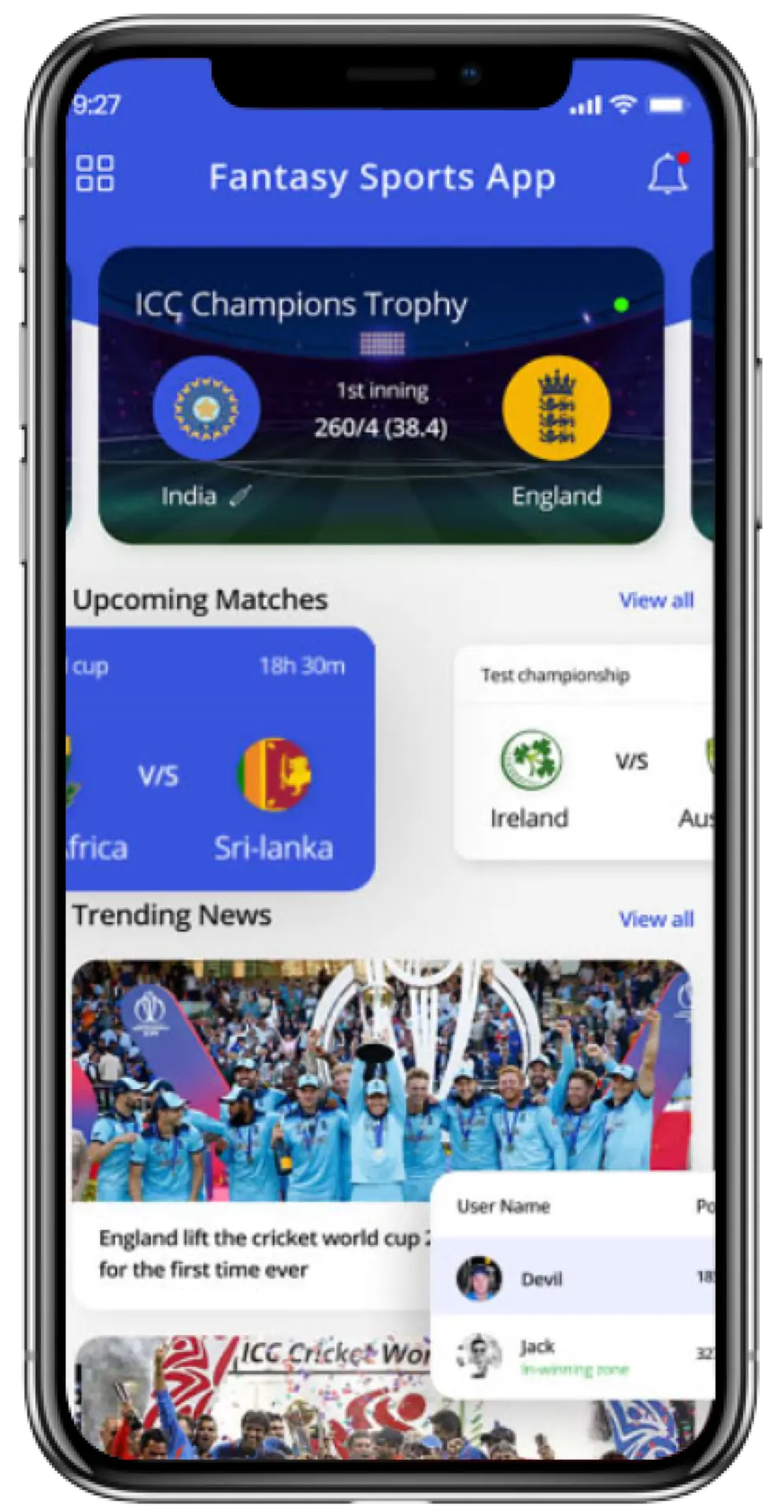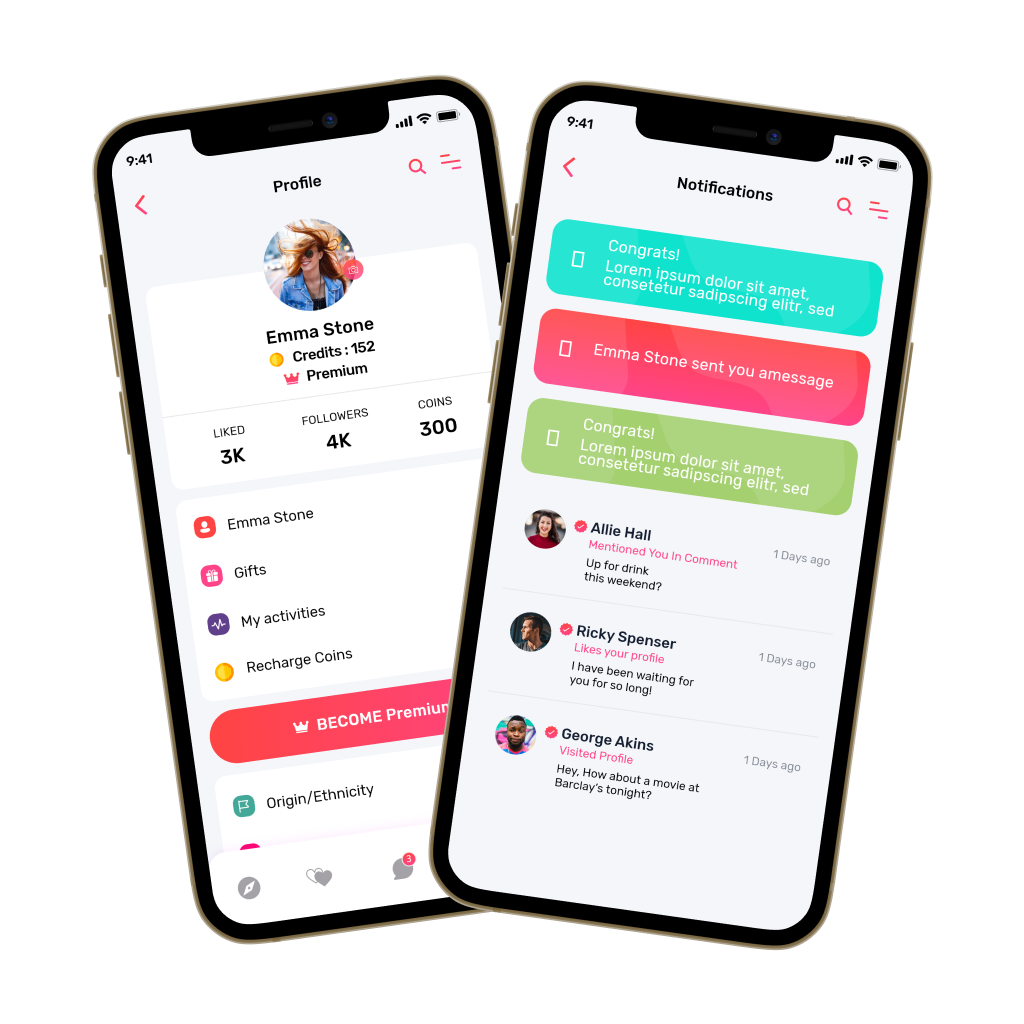Live sports have become a daily habit for millions of fans, but finding a reliable stream still feels uncertain. Viewers often move between broken links, delayed feeds, and platforms that vanish without notice. This inconsistency creates a real opportunity for businesses seeking to build something dependable. Sports streaming apps like Sportsurge are growing because they focus on organized match listings, multiple streaming options, and fast access without forcing signups.
With the right architecture, a platform can intelligently aggregate links, monitor availability, and refresh sources in real time. It should also be built with performance tuning and compliance in mind to avoid common failures.
Over the years, we’ve built multiple sports streaming solutions, powered by low-latency video streaming infrastructure and real-time data aggregation systems. As IdeaUsher has this expertise, we’re sharing this blog to discuss the steps to develop a sports streaming app like Sportsurge. Let’s start!
Sports Streaming Market in 2025
According to Verified Market Research, the global live video streaming market is expected to grow at a CAGR of 28.1% and reach $247 billion by 2027. This surge is driven by increased mobile device usage, faster internet connectivity, and rising demand for real-time content in the sports and entertainment sectors.

Fueling this growth is a perfect storm of factors:
- Fanatical Fan Base: A surge in fan interest in sports is driving demand for live-streaming options. People crave the immediacy and accessibility of watching their favorite teams compete in real time.
- Tech Revolution: The rise of high-speed internet and the proliferation of multi-platform, connected devices are making it easier than ever for fans to access live sports content. No longer are they confined to traditional cable packages.
- Direct-to-Consumer (D2C) Mania: Leagues, clubs, and broadcasters are increasingly offering D2C streaming services, bypassing traditional middlemen. This allows fans more flexibility and potentially lower costs when watching their favorite teams or leagues.
The global sports streaming platform market is valued at $33.9 billion in 2025, with a projected CAGR of 12.6%, expected to reach $75.1 billion by 2030.
In the US alone, 90+ million viewers are expected to stream at least one live sports event per month in 2025, compared to just 57 million in 2021.
Major platforms are investing heavily in content rights—streaming services will account for $12 billion (20%) of global sports rights spending in 2025.
Sports content on SVOD platforms (like Netflix, Prime, Disney+) has grown nearly 8% faster than movie catalogs in early 2025.

What Makes Sportsurge Unique? Features, UX, & Monetization
Sportsurge offers a seamless viewing experience using adaptive bitrate streaming, which ensures minimal buffering even under low bandwidth conditions. It acts as a stream aggregator, guiding users to multiple third-party sources offering live sports events. Its clean UI and broad sports coverage have helped it build a loyal user base without hosting content directly.
Sportsurge vs. Competitors
While Sportsurge has become popular for free access, it faces big drawbacks. Here’s how it compares with licensed alternatives:
| Platform | Coverage & Rights | Features & Quality | Legality & Pricing |
|---|---|---|---|
| Sportsurge | Aggregates unofficial live streams across sports | Free, but with ads/pop-ups; unstable streams | No rights, legal risks |
| DAZN | Global coverage, boxing/UFC, NFL Game Pass Int’l | 4K streams, exclusive content | $20–$30/month |
| ESPN+ | UFC, WNBA, MLB, college sports | Reliable, integrated w/ Disney+ | $12/month or $120/year |
| FuboTV | NFL, NBA, int’l leagues + live channels | Broad coverage, DVR support | $85/month |
| YouTube TV | ESPN, NBC, regional channels | Multi-view, 4K streaming | $83/mo |
Here’s to more what makes Sportsurge unique and beneficial for both users and the platform:
01 Extensive Sports Coverage
Sportsurge boasts a comprehensive library of sports streams, encompassing popular leagues like the NFL, NBA, and MLB, as well as niche categories like MMA and motorsports. This attracts a wider audience and keeps users engaged by offering something for every taste.
02 Effortless Navigation and User-Friendly Interface
Even for non-tech-savvy users, Sportsurge prioritizes a clean and intuitive layout. This ease of use translates to a smoother user experience, encouraging longer viewing times and potentially increased user retention for the platform.
03 High-Quality, Buffer-Free Streaming
Sportsurge strives to deliver a premium viewing experience with minimal buffering and high-definition streams. This keeps users engaged and satisfied, reducing frustration and encouraging repeat visits. Additionally, offering multiple streaming options caters to users with varying internet speeds, further broadening the platform’s accessibility.
04 Ad-Free Live Streams
Unlike traditional streaming services, Sportsurge eliminates intrusive advertisements during live games. This enables users to fully immerse themselves in the action, enhancing their overall enjoyment and potentially leading to more positive user reviews and recommendations.
05 Reliable Service
Sportsurge prioritizes a reliable streaming experience with minimal lag or buffering issues. This ensures users won’t miss out on crucial moments in a game due to technical problems, fostering user trust and loyalty towards the platform.
By combining these features, Sportsurge creates a compelling value proposition for sports fans seeking a free and convenient way to access live streams. This can lead to a bigger user base and potentially attract partnerships or advertising opportunities (depending on the platform’s revenue model), benefiting the business side of Sportsurge.
How Does the Sportsurge App Work?
Sportsurge is not a traditional streaming service. Instead of hosting games itself, it serves as a sports streaming index that aggregates links from third-party sites and organizes them by sport and event. Everything runs through a web browser rather than a downloadable app.
What Sportsurge Actually Does
Sportsurge v2 functions as a central directory for live sports links. It covers a wide range of leagues and events, such as football, basketball, baseball, combat sports, soccer, and motorsports, by listing external streams in one place. The platform itself does not broadcast games. It simply points users elsewhere.
Its pages are event-driven. Games usually appear shortly before they begin, not hours or days in advance. Until a match is about to start, the page may display little or no content. This is normal behavior and does not mean the site is broken.
Typical User Experience
- A user opens Sportsurge in a browser on a phone, tablet, or computer.
- They select a sport, for example, the NBA or the NFL.
- Available games for the day appear as start time approaches.
- Clicking a game reveals several external streaming options.
- If one link does not work well, another can be selected.
The process is simple and repeatable, designed for quick access rather than detailed customization.
Key Characteristics
- No account required. There is no signup or subscription process.
- Multiple sources per event. Most games list several links, offering alternatives if one source is unstable.
- Minimal design. The interface prioritizes speed and readability over visuals or advanced features.
Devices and Access
Sportsurge is primarily used through standard web browsers on desktop and mobile devices. Some users also access it on TVs using browser-based solutions or screen casting, but the experience remains the same. Browse, choose a game, then select a link.
Why Develop a Sports Streaming App Now?
Developing a dedicated sports streaming app offers a strategic advantage by capitalizing on this trend and building a platform that caters to the evolving needs of sports fans. Here’s a deeper dive into the key benefits:

01 Rising Demand and Addressing Piracy
Fan interest in sports content is surging. Traditional cable subscriptions are on the decline, with viewers increasingly seeking flexible and convenient ways to access their favorite teams and events.
However, a surprising disconnect exists, as highlighted by the “Charting Global Sports Piracy” report. This study found that even though 89% of sports fans have paid subscriptions, over half (51%) still resort to pirated content at least monthly. This trend is even more concerning for heavy users, with 42% of those watching illegal streams doing so daily – a staggering 60% higher than the average fan.
Therefore, a well-designed sports streaming app fills this gap by offering a compelling alternative to piracy. By providing live and on-demand content readily available on various devices, along with a user-friendly experience, you can capture this audience currently seeking illegal streams and convert them into loyal paying subscribers.
02 Diverse Monetization Opportunities
Sports streaming apps move beyond the limitations of a single revenue stream. Subscription plans are a core option, but the app can be further monetized through strategic partnerships. For instance, the app can offer in-app advertising deals with relevant sports brands or pay-per-view access to exclusive events like high-stakes matches or behind-the-scenes documentaries.
Additionally, the app can serve as a platform for merchandise sales, allowing fans to purchase team jerseys or other sports apparel directly within the app. This diversification creates a robust revenue model that isn’t solely reliant on subscriber numbers.
03 Loyal and Engaged Fan Community
A dedicated app goes beyond simply streaming games. It can foster a vibrant and engaged fan community. Push notifications can keep users updated on upcoming games, player news, and exclusive content drops.
Interactive features like live chats, polls, and fantasy sports integration can further enhance the experience. Fans can debate game strategies in real-time chat rooms or participate in interactive polls to predict game winners. This fosters a sense of community and keeps fans coming back for more than just the games themselves.
04 Expanding Reach to a Global Audience
The beauty of the Internet is in its ability to transcend geographical barriers. A well-developed app, with localized content options where applicable, can attract fans from all corners of the world. This translates to a significantly larger potential user base compared to traditional regional broadcasters. By catering to international audiences, the app opens doors to new sponsorship and advertising opportunities, further bolstering its revenue potential.
05 Future-Proofing Business
The cord-cutting trend is undeniable. Consumers are increasingly ditching cable subscriptions in favor of streaming services that offer flexibility and affordability. By developing a sports streaming app, you position your business at the forefront of this revolution.
You cater to the changing consumption habits of viewers and ensure your business remains relevant and competitive in the ever-evolving media landscape. This proactive approach creates a sustainable business model with the potential for long-term growth.
Sports Media Rights: A Booming Investment
In the United States alone, sports media rights—spanning television and digital streaming—have surged dramatically.
S&P Global reports that sports media rights spending reached $29.54 billion in 2024, up from $14.64 billion in 2015, and is expected to approach $35 billion by 2027.
This surge underlines how streaming services like Amazon Prime Video, ESPN+, and Peacock are driving record-breaking rights deals, signaling massive opportunities for new entrants that can deliver quality sports content within legal and profitable frameworks.
Piracy Trends and Their Business Implications
Despite the rapid rise of legitimate streaming options, piracy remains a global challenge.
The Synamedia / Ampere Analysis “Charting Global Sports Piracy” report revealed that while 89% of sports fans already pay for official subscriptions, more than 51% still consume pirated sports streams at least once a month.
Interestingly, 42% of heavy pirates watch fixtures daily, demonstrating the high engagement potential within this audience segment.
Addressing piracy through affordable, accessible, and feature-rich apps can help convert these viewers into loyal, paying users.
Changing Viewer Demographics and Streaming Adoption
A 2025 Performance Research / Full Circle study highlights how streaming has become the default viewing method for sports worldwide:
- 9 out of 10 sports fans now watch through streaming platforms.
- 65% use Amazon Prime Video, 39% ESPN+, 37% Peacock, and 32% Paramount+.
- 63% of Gen Z and 56% of Millennials increased their streaming usage in the past year, compared with 35% of Gen X and 21% of Boomers.
These generational patterns reveal that younger audiences expect on-demand, mobile-first, and socially integrated experiences critical considerations for anyone developing the next Sportsurge-like platform.
Global Fan Engagement and Monetization Trends
Insights from GWI’s 2025 Sports Viewership Trends show dramatic behavioral shifts among fans:
- The number of fans using Amazon Prime Video for sports increased 59% since 2021.
- Millennials (19%) are most willing to pay for sports content, followed by Gen Z (18%), Gen X (9%), and Boomers (5%).
- Live sports consumption via social media rose 34% between 2020 – 2024.
These patterns emphasize the importance of flexible pricing, social-streaming integration, and multi-platform accessibility in building profitable sports-streaming ecosystems.
Why Data-Driven Positioning Matters
Integrating these global and regional insights makes your blog stand out from generic “how-to-build” guides.
It demonstrates authority, market understanding, and strategic foresight—key ranking factors in Google’s Experience – Expertise – Authoritativeness – Trustworthiness (E-E-A-T) framework.
You can conclude the section by connecting these insights to Idea Usher’s development capabilities—emphasizing how the company can build secure, scalable, and compliance-ready sports streaming platforms tailored for global audiences.
U.S. Customer & Feature Priorities
With U.S. viewers increasingly shifting to streaming, app features and monetisation strategies must align with American expectations:
- Subscription models tied to exclusive or high-profile sports events remain dominant in the U.S. rights-spending data.
- Technical quality is a differentiator in the U.S. market where bandwidth is high and expectations are elevated.
- A focus on mobile + multi-device usage: U.S. sports viewers expect viewing on smartphones, tablets, smart TVs, and “second-screen” experiences.
- Community and social features (real-time chat, statistics overlays, fantasy/in-game interaction) can drive engagement and retention in U.S. streaming audiences.
- Consider tiered pricing or bundled offerings to differentiate from piracy and legacy cable bundles.
Must-Have Features to Develop a Sports Streaming App Like Sportsurge
While Sportsurge may offer free live streams, it’s crucial to build your app with legal and licensed content in mind. Here are the essential features of a successful sports streaming app that will keep users engaged and coming back for more:

01 Extensive Sports Coverage
Cater to a wider audience by offering a vast library of sports content. Include popular leagues like the NBA, NFL, and MLB, as well as international favorites like soccer and cricket. But don’t stop there! Consider niche sports like rugby, boxing, or MMA to cater to specific fan interests and set yourself apart from the competition.
02 User-Friendly Interface and Navigation
Prioritize a clean and intuitive design that even non-tech-savvy users can navigate with ease. This means a clutter-free layout, easily identifiable icons, and a logical organization of menus and categories. Users should be able to find their desired sports and events quickly, minimizing frustration and keeping them engaged in the app.
03 High-Quality, Buffer-Free Streaming
A seamless viewing experience is paramount—partner with reliable streaming providers to offer high-definition streams with minimal buffering or lag. Also, consider offering adaptive bitrate streaming, which automatically adjusts video quality depending on the user’s internet speed. This ensures accessibility for users with varying bandwidths and avoids frustration caused by choppy playback.
04 Multi-Platform Compatibility
Today’s viewers consume content on various devices. Make sure your app is accessible on smartphones, tablets, smart TVs, and potentially even gaming consoles. This broadens your target audience and caters to fans who wish to enjoy their favorite sports on the go or on a bigger screen for an immersive experience.
05 Personalized Content Discovery
Help users discover new content they might like and go beyond simply browsing by sport. Implement features like personalized recommendations based on viewing history or location-based suggestions for local teams. You can even incorporate curated content collections or editorial spotlights on up-and-coming players or rising stars to keep things fresh and engaging.
06 Live Scores and Real-time Updates
Die-hard sports fans crave constant information. Keep users engaged with real-time scores, game statistics, play-by-play updates, and breaking news for their favorite teams and sports. Integrate a dedicated “live scores” section or consider push notifications to keep users informed of game highlights, crucial moments, or unexpected upsets – even if they aren’t actively watching a stream.
07 Social Media Integration
Foster a sense of community and enhance user engagement by allowing fans to share their viewing experience and connect with each other on social media platforms (depending on your app’s policies). This could involve integrated sharing buttons, in-app forums or chat rooms for discussions, or even live feeds showcasing fan reactions during games.
08 Multiple Language Support
The sports world is a global phenomenon. Expand your reach to a bigger audience by offering your app interface and content in multiple languages. Cater to the growing international sports fan base and open doors to new markets where your app might not have been accessible before.
09 Advanced Search Functionality
A robust search bar is an essential tool for users who know exactly what they’re looking for. Add a search function that lets users find specific teams, players, games, or events quickly and efficiently. Consider features like auto-complete suggestions and filters by sport, league, or date to refine search results further and enhance user experience.
10 Chromecast and AirPlay Compatibility
Enable users to easily cast their app content onto larger screens for an enhanced viewing experience. Integrate compatibility with popular casting technologies like Chromecast and AirPlay, allowing users to seamlessly stream games or sports content from their mobile devices to smart TVs or projectors. This caters to fans who want to share the experience with friends and family or enjoy sports on a bigger screen for a more immersive atmosphere.

Steps to Develop a Streaming App Like Sportsurge
To develop a streaming app like Sportsurge, the process should begin with defining how live streams will be sourced and verified in real time. A low-latency streaming architecture must then be engineered to handle sudden traffic spikes and fail over reliably when streams drop.
Over the years, we have developed numerous streaming apps like Sportsurge and this is how it is usually done.

1. Aggregation & Licensing Strategy
We start by aligning the business model with the right content strategy using licensed live feeds, FAST channels, or distribution partnerships based on the client’s region, audience, and regulatory requirements. Our team maps supported sports, leagues, and territories early, ensuring geo-compliance, blackout rules, and rights constraints are built directly into the platform logic.
2. Live Stream Discovery Engine
We design a real-time discovery engine that continuously indexes live events and organizes them by sport, league, kickoff time, and region. Streams are automatically ranked using internal health scores such as startup speed, buffering rate, bitrate stability, and historical reliability, so users always see the best option first.
3. Implement Low Latency Streaming
To meet live sports requirements, we deploy ultra-low-latency streaming using LL-HLS for broad device support and WebRTC, where sub-second latency is critical. We configure edge-optimized CDNs with fine-tuned caching and segment strategies to handle traffic surges during major events.
4. Integrate Real-Time Sports Data
We integrate live scores, odds, and advanced stats through trusted sports data providers and synchronize them precisely with video playback using timestamp alignment and delay offsets. This ensures that score updates, play-by-play data, and odds changes never appear ahead of the stream.
5. Zero-Friction User Experience
Our UX strategy prioritizes instant access through guest mode, no-login previews, and one-tap entry into live games. We build game-card-based interfaces that surface the most important information, including live score, clock, match status, and stream quality without clutter.
6. Secure, Test, and Scale
Before launch, we harden the platform against real-world conditions with DDoS protection, traffic throttling, and continuous observability across streaming, APIs, and infrastructure. We conduct stress tests using match-day simulations that replicate kickoff spikes and mass-reconnect scenarios.
How Much Does It Cost to Develop a Sports Streaming App in 2025?
Here’s a breakdown of the estimated costs for different types of sports streaming apps:
| Feature/Component | Basic App ($20,000 – $50,000) | Mid-Range App ($50,000 – $150,000) | Advanced App ($150,000+) |
| User Interface Design | $2,000 – $5,000 | $5,000 – $10,000 | $10,000 – $20,000 |
| High-Quality Video Streaming | $3,000 – $7,000 | $7,000 – $15,000 | $15,000 – $30,000 |
| Live Scores and Statistics | $1,000 – $3,000 | $3,000 – $7,000 | $7,000 – $15,000 |
| Multi-Sport Coverage | $2,000 – $4,000 | $4,000 – $8,000 | $8,000 – $15,000 |
| Interactive Features | $5,000 – $10,000 | $10,000 – $20,000 | |
| Personalized Content | $5,000 – $10,000 | $10,000 – $20,000 | |
| Multiple Viewing Options | $2,000 – $4,000 | $4,000 – $8,000 | $8,000 – $15,000 |
| On-Demand Content | $5,000 – $10,000 | $10,000 – $20,000 | |
| Offline Viewing | $3,000 – $7,000 | $7,000 – $15,000 | |
| User Authentication and Security | $1,000 – $3,000 | $3,000 – $7,000 | $7,000 – $15,000 |
| Analytics and Insights | $5,000 – $10,000 | $10,000 – $20,000 | |
| Ad Integration and Sponsorships | $3,000 – $7,000 | $7,000 – $15,000 | |
| Customer Support | $1,000 – $3,000 | $3,000 – $7,000 | $7,000 – $15,000 |
| Project Management | $2,000 – $4,000 | $4,000 – $8,000 | $8,000 – $15,000 |
| Quality Assurance and Testing | $2,000 – $4,000 | $4,000 – $8,000 | $8,000 – $15,000 |
| Maintenance and Updates | $2,000 – $4,000 | $4,000 – $8,000 | $8,000 – $15,000 |
These are estimates. The final cost of your sports streaming app will depend on the specific feature set you choose, the complexity of development, and the team you hire.
The cost of developing a sports streaming app can be influenced by several factors, including:
When planning to develop a sports streaming app like Sportsurge, understanding the cost breakdown is essential. Several key factors contribute to how much you’ll need to invest. Below is a detailed list, each explained in context:
1. App Complexity and Features
The more advanced and feature-rich your app, the higher the development cost. A simple app offering basic functionalities such as live streaming, match scores, and game schedules will be relatively affordable. However, if you’re looking to integrate advanced features like social media sharing, fantasy sports modules, or personalized recommendations powered by AI, expect development time and costs to increase significantly.
- Basic features: Live streaming, match schedules, scoreboards
- Advanced features: Fantasy leagues, chat, push notifications, AI-based recommendations
2. Development Team Location and Hourly Rates
The geographic location of your development team heavily influences cost. For instance, hiring developers in South Asia or Eastern Europe is generally more economical than hiring them in North America or Western Europe. However, lower rates may come with trade-offs in communication, time zone alignment, or platform expertise. It’s crucial to balance budget considerations with experience and quality when choosing your development partner.
- Lower-cost regions: India, Ukraine, Philippines
- Higher-cost areas: USA, UK, Canada
- Considerations: Time zone, English proficiency, development speed
3. Platform Compatibility
Developing your app for multiple platforms, such as Android, iOS, and the web, can significantly increase both development time and costs. If your target audience primarily uses one specific platform, it may be more cost-effective to start with that platform first. Later on, you can scale to cross-platform solutions using tools like Flutter or React Native, which can help manage long-term expenses.
- Single platform: Lower cost and faster time-to-market
- Multi-platform: Broader audience reach but higher development effort
4. Content Licensing Costs
Securing the legal rights to broadcast sports content is one of the most significant expenses in streaming app development. Licensing fees vary depending on the type of content (live events vs. highlights), the sports category, and the regions you plan to serve. Without proper licensing, streaming copyrighted content can lead to legal issues, so this cost should never be underestimated.

How to Monetize a Sports Streaming App
Monetizing a sports streaming platform involves choosing the right model that balances user experience with revenue. Common options include:
- Subscription Model (SVOD): Charge users a recurring fee for access to exclusive content.
- Advertising (AVOD): Include pre-roll, mid-roll, or banner ads to earn revenue per view or impression.
- Freemium Model: Offer basic streaming for free and charge for premium content or HD access.
- Pay-Per-View (PPV): Charges per match or tournament access, ideal for high-profile events.
Why Sports Streaming Apps Saw a 43% Viewership Growth?
The change is evident as digital sports streaming viewership increased by 43 percent year over year, with more than 1 million viewers on average per platform. Streaming services could handle this growth because cloud-based delivery and adaptive bitrate technology support large live audiences at scale. Viewers may gradually shift away from cable as streaming offers flexible access and consistently reliable performance.

1. A Pandemic Shift That Stuck
The pandemic forced millions of fans to try streaming for the first time. What surprised broadcasters was that many did not go back.
During lockdowns, viewers realized streaming solved long-standing frustrations:
- Fewer geographic restrictions, making it easier to follow favorite teams
- Device flexibility, allowing fans to watch on phones, tablets, or TVs
- Freedom from cable bundles, which often required paying for channels they never watched
What began as a workaround quickly became a preference.
2. A High-Stakes Race for Sports Rights
Streaming platforms did not just follow demand. They invested heavily to accelerate it.
Major deals reshaped the sports media landscape:
- Amazon Prime Video secured exclusive Thursday Night Football rights
- Apple TV+ is locked in a long-term Major League Soccer agreement
- YouTube TV became the home of NFL Sunday Ticket
- Netflix began experimenting with live sports programming
These deals did more than add content. They normalized the idea that major live sports belong on streaming platforms, not just cable networks.
3. Younger Viewers Are Changing the Rules
Millennials and Gen Z fans consume sports differently from older audiences, and they now represent a growing share of total viewership.
Key behavior shifts include:
- Mobile-first viewing, with many younger fans watching games on phones or tablets
- Second-screen habits, where live sports are watched alongside social media
- Personalized consumption, favoring highlights, alternate angles, and tailored feeds
- Social viewing through group chats, watch parties, and live reactions
Streaming platforms are built around these habits. Traditional TV is not.
4. Streaming Fixed What Broadcast TV Could Not
Many of the frustrations fans accepted for years simply do not exist on streaming platforms.
| Traditional Broadcast | Streaming Platforms |
| Fixed start times | Flexible replays and restarts |
| Limited camera angles | Multiple viewing options |
| Uniform commentary | Custom audio and feeds |
| Interruptive ad breaks | Targeted, dynamic ads |
| Hardware-locked | Watch on any device |
The result is a viewing experience that feels designed for the user, not the network.
5. Data and Personalization Power the Experience
Behind the scenes, data helps sports streaming apps keep viewers engaged by enabling predictive buffering for smoother playback and by generating automated real-time highlights. Viewing behavior also supports smarter recommendations, while live stats, fantasy overlays, and in-game insights enhance the experience.
Together, these data-driven features improve performance and encourage users to stay longer and return more often.
Monetizing Sports Streaming with Micro-Rights
The “All-You-Can-Eat” sports subscription model is hitting a wall. As prices rise and content fragments across a dozen platforms, fans are pushing back against paying for an entire buffet when they want only a single dish. The next market leader will not win by locking down more leagues. It will win by unbundling the game itself.
This is the rise of Micro-Rights, a fundamental shift from subscription bulk to transactional precision that solves the long-tail monetization problem.
Subscription Fatigue and the “One-Team Fan”
The business problem is clear. The current model ignores how most people actually watch sports. The average fan is not a die-hard who watches every game of a season.
They are the “One-Team Fan” who follows their local club, or the “Moment Chaser” who only tunes in when the stakes are highest, such as the final innings, overtime, or a rivalry game.
Paying $30, $40, or even $70 per month for access to hundreds of channels or thousands of games is a poor value proposition for this viewer. The result is a hard no. They turn to unofficial streams, follow on social media, or simply disengage. This leaves a massive, underserved audience and billions in potential revenue on the table.
The Disruption
The disruption lies in implementing event-based micro-transactions. Imagine a platform where access is not sold by the month or the season, but by the moment.
- Pay $0.99 to watch the last 10 minutes of a tied championship game.
- Unlock the post-match press conference for $0.49 to hear the coach’s reaction.
- Purchase a player-cam feed for a specific star athlete for a single game for $1.99.
- Buy a catch-up reel for $0.79 if you join a match late and need a summary of key plays.
This is enabled by secure, transparent blockchain-backed ledgering, which allows for the creation, sale, and verification of millions of these tiny, unique digital assets instantly and without fraud.
Capturing the Impulse Economy
This model builds a powerful strategic moat by targeting a behavior that subscriptions miss. It captures the impulse to watch right now.
It reaches the millions of fans who see a score alert on their phone, notice a game trending on social media, or get a text from a friend saying, “You have to see this.” In that moment, they will not sign up for a monthly contract. They will tap once, pay a dollar, and join the live climax.
- For fans, it eliminates financial friction and aligns cost with actual value and interest.
- For rights holders, it unlocks monetization for every segment of the game. This includes not just the premium live broadcast, but also the archive, press conferences, alternative feeds, and tactical camera angles that were previously cost centers.
Case Studies: The Pioneers of Flexible Access
1. DAZN’s Event Pass
While DAZN is primarily subscription-based, it has strategically used one-off event passes for mega-fights outside its core rights package.
For example, it has offered access to a single major boxing match for a fixed fee, typically $20 to $30, allowing casual fans to purchase without a monthly commitment.
This model directly targets the moment chaser and provides a clear blueprint for how a micro-rights platform could function at a smaller, more frequent scale, such as $2.99 for the final quarter of an NBA playoff game.
2. Apple TV+ and MLS Season Pass
Apple’s approach with Major League Soccer is a step toward unbundling. For a flat fee, fans get every single MLS game, with no blackouts and no fragmentation. While still a bundle, it is targeted and league-specific rather than a large cable package. This proves fans will pay for a coherent, complete experience around a specific interest.
3. ESPN+ and UFC PPV
ESPN+ perfectly illustrates the tiered approach. A monthly subscription provides access to a vast library and a range of live events. However, the biggest UFC pay-per-view events cost an additional $70 to $80 on top of the subscription fee. This is the existing, clunky version of micro-transactions. Friction is high due to the double paywall, but demand is proven.
How Sports Streaming Apps Secure Broadcasting Rights?
Sports streaming apps secure broadcasting rights by negotiating licenses directly with leagues and broadcasters, which may define where and how content can be shown. They must then enforce those rules using geo-blocking and DRM so streams can only play on approved devices and regions.
1. The Rights Acquisition Process
The journey begins at the source, the rights holders. These include:
- Sports Leagues (e.g., NFL, Premier League, NBA)
- Teams and Franchises (e.g., Manchester United, New York Yankees)
- Event Organizers (e.g., IOC for the Olympics, Wimbledon Committee)
- Broadcast Networks that may sub-license rights (e.g., ESPN, Sky Sports)
Platforms negotiate for specific packages of rights, which are typically carved up by the following dimensions:
| Dimension of Rights | What It Controls | Example |
| Territory | Geographical region where the content can be shown | A platform may buy rights for the USA only or all of Europe, excluding Italy |
| Platform | Type of device or service | Mobile-only rights, digital OTT rights, or traditional TV plus streaming |
| Language | Audio and commentary tracks | Exclusive rights to Spanish-language commentary in North America |
| Exclusivity | Whether others can broadcast the same content in the same territory | An exclusive deal means no other legal streamer can show those games in that region |
| Time Window | Duration of the license | A five-year deal for UEFA Champions League rights or a ten-year deal for MLS |
2. Geo-Blocking and DRM
Once rights are acquired, platforms must technically enforce these contractual boundaries.
Geo-Blocking (Geo-Fencing): The most common tool. The app uses the user’s IP address to determine their physical location. If a user in London tries to access a stream licensed only for the USA, they will be blocked with a message stating that the content is not available in their region.
Digital Rights Management (DRM): Systems like Google Widevine, Apple FairPlay, and Microsoft PlayReady encrypt the video stream. They prevent users from downloading, copying, or illegally redistributing the content, ensuring it is only played back on authorized apps and devices.
3. The Legal and Illegal Spectrum
It is crucial to distinguish how different types of services handle rights.
| Service Type | Rights Management Model | Key Risks and Limitations |
| Official Licensed Platforms (e.g., ESPN+, DAZN, Peacock) | Purchase official licenses and enforce territorial limits | Very high costs and frequent blackout restrictions |
| Social and FAST Platforms (e.g., YouTube, Amazon Freevee) | Mix licensed content with user uploads and takedown systems | Ongoing infringement issues and compliance burden |
| Unauthorized Aggregators (e.g., Sportsurge, BuffStreams) | Link to unlicensed third-party streams | Legal exposure, unstable streams, and security risks |
The Modern Challenge: Fighting Piracy in Real Time
For official broadcasters, piracy is a daily battle. They employ sophisticated anti-piracy firms that monitor illicit streams using automated bots, issue thousands of takedown notices to hosting providers and ISPs, and embed invisible watermarking codes into broadcasts to trace leaks back to their source.
The Strategic Shift: New Models Emerging
The industry is evolving to address the high cost and fragmentation caused by traditional rights models.
- Direct-to-Consumer by Leagues: Organizations like the NFL with NFL+ and MLB with MLB.TV stream games directly in certain contexts, reducing reliance on traditional broadcasters.
- Global vs. Local Rights: There is a growing push to sell more global rights packages to large technology companies, such as Apple’s deal with MLS, which reduces fragmentation and simplifies access for fans.
- Blockchain for Micro-Rights: An emerging concept involves using blockchain technology to manage and automate extremely granular rights, such as individual highlight clips or archive moments, enabling new revenue streams and clearer ownership records.
Managing Cancellations & Stream Failures in Sports Streaming
For sports streaming platforms, the most critical test is not broadcasting a perfect game. It is handling the moment when the game disappears.
When a match is abruptly cancelled due to weather, a stream fails mid-play, or a major event crashes the system, the user experience hinges entirely on the platform’s crisis response. This behind-the-scenes resilience is what separates professional services from amateur aggregators.
1. Building Systems That Anticipate Failure
The first line of defense is resilient infrastructure.
| System Component | Failure-Prevention Strategy | Real-World Application |
| Content Delivery Network (CDN) | Use multiple CDN providers to reroute traffic instantly if one fails | During a major Champions League final, a streamer shifted two million viewers to a backup CDN in under ten seconds |
| Encoding and Origin Servers | Run active-active servers across regions to ensure seamless takeover | A platform with servers on both coasts can lose one region without interrupting the stream |
| Monitoring and Alerting | Track stream health in real time with automated alerts | Systems detect encoder failures or ISP outages and trigger fixes automatically |
2. The Playbook for Sudden Match Cancellations
When a scheduled event does not start, chaos follows. Professional platforms execute a clear playbook.
Immediate Automated Response
- The platform’s scheduling system, integrated with official league data feeds, receives a cancellation flag.
- The stream is automatically replaced with a holding screen within seconds rather than minutes.
- Push notifications are triggered to all users who added the event to My Games, stating that the game has been postponed with a prompt to tap for details.
Content Contingency Plan
- A pre-produced video loop with updated information, interviews, or analysis is queued.
- The app’s UI dynamically updates. The Live badge disappears and the event is moved to a Postponed section.
- For subscribers, on-demand content such as highlights from a previous game or a related documentary may be prominently suggested to retain engagement.
3. The Protocol for Mid-Stream Failures
When a live stream fails during a game, every second of silence costs viewers and trust.
Detection and Diagnosis (0 to 15 seconds)
Automated monitoring tools pinpoint the root cause of the failure. This may be the venue feed, the primary encoder, or a specific CDN node.
Automatic Failover (15 to 30 seconds)
Systems switch to a redundant backup stream. This is often a slightly lower bitrate feed from a separate encoder path, ensuring continuity while the primary issue is resolved.
User Communication (Ongoing)
A non-intrusive, persistent on-screen message appears informing users that an interruption is being addressed and that the stream is live via a backup feed.
The Catch-Up Buffer
To prevent viewers from missing pivotal moments during an outage, platforms with DVR functionality allow users to rewind to the point at which the stream cut out.
4. Communicating During a Crisis
Technical recovery is only half the battle. Communication determines whether frustration turns into trust.
Transparency Over Silence
A status page or in-app alert provides clear, concise updates such as identifying a source feed interruption from the stadium and confirming that a backup stream is active while full restoration is underway.
Proactive Refunds or Credits
For Pay-Per-View events that fail catastrophically, platforms often issue automatic partial refunds or credits toward a future event. This goodwill gesture frequently generates more long-term loyalty than the cost of compensation.
Post-Mortem and Accountability
After a major incident, publishing a brief and honest post-incident report explaining what happened and what improvements are being made builds strong technical credibility with the user base.
Recommended Tech Stack for Building a Sports Streaming App
Choosing the right tech stack ensures a smooth, scalable, and secure streaming experience:
- Frontend: React Native, Flutter, Swift (iOS), Kotlin (Android)
- Backends: Node.js, Python (Django), Ruby on Rails
- Streaming Protocols: HLS, MPEG-DASH, RTMP
- Cloud Hosting: AWS, Google Cloud, DigitalOcean
- Database: PostgreSQL, MongoDB, Firebase
- Security: SSL encryption, DRM, Token-based authentication
Conclusion
The rising popularity of platforms like Sportsurge proves there’s a huge demand for high-quality, on-demand sports streaming experiences. Whether you’re targeting a niche audience or aiming to compete with big players, building a successful sports streaming app requires careful planning, the right feature set, smart monetization strategies, and an experienced development team.
Looking to Develop a Sports Streaming Platform like Sportsurge?
IdeaUsher can help you design a scalable sports streaming platform that is intuitive, compliant, and performant. We will guide you through architecture choices, CDN integration, and stream aggregation so you can launch efficiently and securely.
With over 500,000 hours of coding experience, our team of ex-MAANG/FAANG developers constructs winning platforms:
- Ultra-Low Latency (under 2 seconds): Implement cutting-edge protocols that eliminate spoilers and make live streams feel truly instant.
- Intelligent Legal Aggregation: Architect a smarter directory. Seamlessly unify feeds from multiple official sources into one clean, intuitive interface.
- Community-Driven Reliability: Build user trust with sophisticated features like community-verified stream health scores, moving beyond risky, blind clicks.
- Architected for Massive Scale: Deploy infrastructure designed to handle traffic surges from events like the Super Bowl without performance loss.
Explore our portfolio to see our engineering in action. Let’s discuss building your platform.
Work with Ex-MAANG developers to build next-gen apps schedule your consultation now
FAQs
A1: To develop a sports streaming app, you should understand your audience and the type of sports content you will stream, because this defines the technical direction. You must build a reliable streaming setup that uses adaptive bitrate technology and secure content delivery to ensure smooth playback. The backend should manage live data and users, while the frontend focuses on fast loading and low-latency viewing.
A2: The cost of developing a sports streaming app depends on features, infrastructure, and performance needs. A basic platform may cost less when it includes standard live streaming and simple user management. As advanced features such as real-time statistics and scalable cloud services are added, the budget increases.
A3: A sports streaming app should support both live and on-demand streaming, with adaptive quality based on network speed. Core features include secure login, match schedules, and real-time scores. Technically, the app must focus on low-latency streaming and reliable data integration.
A4: The time to develop a sports streaming app varies, based on complexity and team experience. A basic version may take about three months, with clear planning and fast execution. More advanced platforms can take longer due to testing and performance optimization.




















